In every biennial budget, the revenues and expenditures for two consecutive fiscal years are passed as a single biennial budget. Changes must always be made to the baseline estimates for the second year of the budget through the mid-cycle process because projected revenues and expenditures usually shift and change as emerging economic and staffing factors become apparent. The Mayor again republishes the previously passed baseline budget with changes in May, then Council modifies that through its process to create a balanced budget for the second year of the biennial. That's what usually happens, and it's often contentious. But this year the process has been a wilder ride than usual.
Back to Back Deficits Create a Daunting Mid-Cycle Process
FY 24-25’s mid-cycle amendment process promised to be far more difficult than most as the City already faces a historic budget deficit in the current fiscal year, with revenues that failed to meet growth predictions. Though most departments are predicted to come in under budget this fiscal year, OPD will likely over-spend its budget by around $26 MM, eliminating the savings and causing the expenditure side to go over budget as well.
Budget reports released quarterly have painted a dire, though mildly improving, snapshot of the City’s general purpose fund budget in the current year—the FY 23-24 budget deficit was predicted to be $177 MM several weeks ago, but is now closer to $150 MM, and effectively around $66 MM after accounting for last year’s surplus of over $90 MM. At the beginning of May, it appeared that regardless, a historic FY 23-24 deficit would be carried into the FY 24-25 budget year which already promises a similar deficit without drastic measures. And when Mayor Sheng Thao missed the deadline to publish the FY 24-25 Mid-Cycle Amendments, many feared the situation was even worse than imagined.
The FY24-25 City of Oakland budget release was planned for tomorrow, but it appears its going to be delayed---but from what I'm told, for good news, rather than bad. Stay tuned.
— Jaime Omar Yassin (@hyphy_republic) May 17, 2024
Thao’s Hat Trick: Selling City's Share of Coliseum Complex, Balancing this Year’s Budget, and Next
But it turned out the Thao administration put the release of the budget on hold because it was closing in on an out-of-the-box solution—the Thao administration had been in negotiations to sell the City’s 50% share of the Coliseum for $105 MM to the African American Sports and Entertainment Group [AASEG]. Thao announced the deal at a press conference held at Castlemont High School last Wednesday, with principals from AASEG and East Oakland residents participating.
The AASEG/City of Oakland presser at Castlemont is wrapping up. Dir of Black Cultural Zone, AASEG, Mayor and students all presented. A very hopeful vision for East Oakland, but devil is always in details pic.twitter.com/Owq7s4shMV
— Jaime Omar Yassin (@hyphy_republic) May 22, 2024
The sale of the 50% ownership of the Coliseum promises to obviate the worst cuts necessary in this year’s budget and the next, allowing Oakland to avoid layoffs of dozens of workers, closure of firehouses and a reduction in police services that would be necessary without it.
Transaction Details Still Murky
The processes for AASEG payment of the funds, and when they may happen, are still unclear. Thao’s office had told the East Bay Times that AASEG will pay the City 60% of the cost in the coming weeks in a staggered payment plan, with the remainder coming next year. But a City Administrator’s report to be heard tomorrow at a Special Council Meeting, states that the entire amount is to be paid in this fiscal year where it will be partially used to pay down the current deficit. The remainder would then be used next year to cover the FY 24-25 deficit.
The City Administrator’s report states that cost cutting measures like slashing overhead and carry-overs are planned to reduce this year’s deficit to $41.9 MM. An accompanying table shows that amount being paid off by a portion of the $105 MM. That would balance the FY 23-24 budget. In the table, the remainder of around $63.1 MM is carried over into FY 24-25, where, along with staffing freezes, it helps balance that structural deficit.
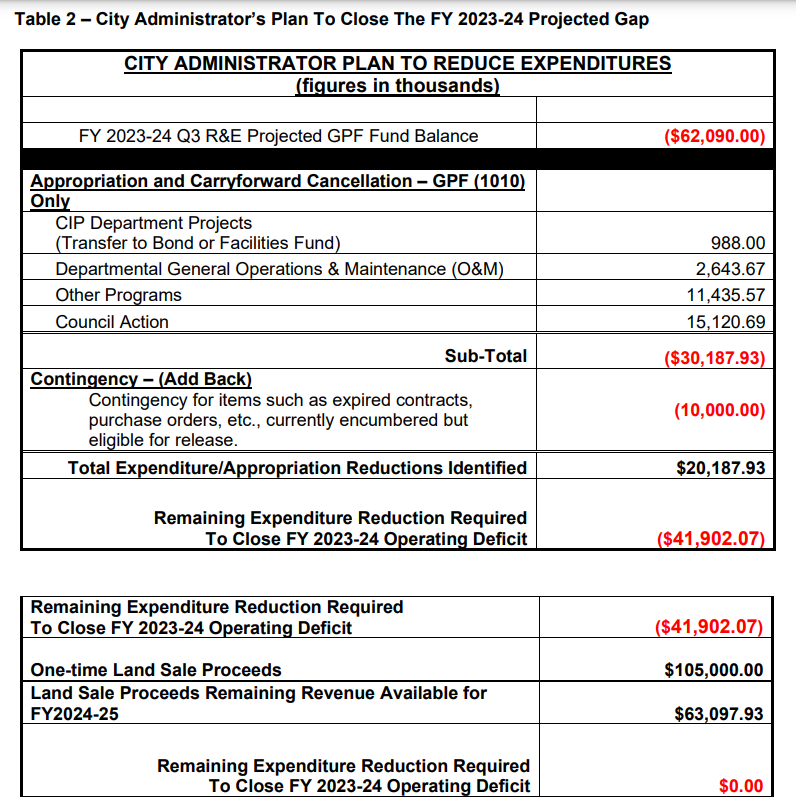
Thao’s FY 24-25 budget released on Friday night appears to log that Coliseum sale remainder in the Miscellaneous Revenue category [combined with the baseline amount that would have accrued there, $1.226 MM]. But the remaining Coliseum sale amount would appear to also be around the same if only 60% of the total were available to pay off the deficit this fiscal year, and the remainder were carried over to next year, where it could be added to the additional 40%. It's still unclear which scenario will be used.
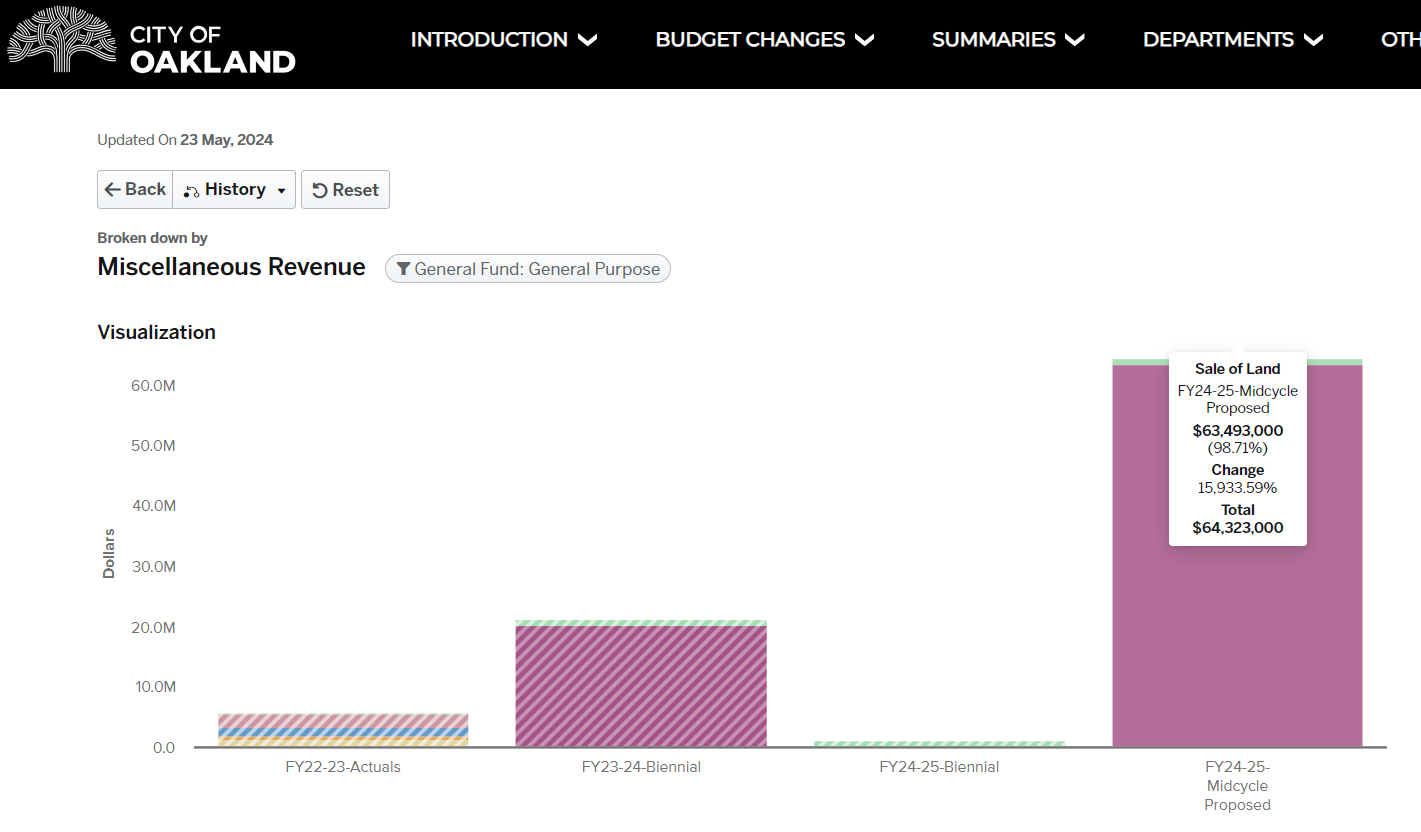
The Oakland Observer sent inquiries over the holiday weekend asking for details of the payment plan, but there were no responses by press time. Thao initially said at last Wednesday's Castlemont press conference that the Development Agreement for the sale would be scheduled at last Thursday’s rules committee. But the DA was postponed. A spokesperson for the Thao administration told this publication at the time that it would be scheduled at this week’s Rules meeting, but the current rules committee agenda is not yet finalized and the DA is not on it, though time remains to add it.
The kinds of benchmarks that would be required or allowed in a cash purchase are unknown. But the Council and the public would be required to parse any such agreement in weeks, rather than months.
AASEG’s Long Road to the Coliseum
Though some have criticized Thao’s Coliseum sale as rushed, the AASEG project is neither sudden nor new. The City’s sale of its 50% Coliseum ownership grew out of the coercive stalemate created by John Fisher’s Howard Terminal boondoggle in 2020. The County sold its 50% share of the Coliseum to Fisher in 2019, but despite arguing that developing the Coliseum site was integral to plans at Howard Terminal, the A’s showed no hurry in settling the ownership split. Rather, the A’s seemed to use the ownership as added pressure to accomplish goals for a stadium development at Howard Terminal.
The City moved in its own direction as the prospects of a cooperative agreement with the A’s on the Coliseum or Howard Terminal steadily worsened, opening up a process to sell its share of the land to AASEG and eventually penciling an Exclusive Negotiating Agreement [in early 2023], the key opener to a development land sale the trajectory of which began in 2021. But Fisher continued to brush off attempts at unifying the site even after he moved on from Howard Terminal to Vegas. It appears the A’s may finally be willing to sell and move on, according to Brodie Brazil, historically a mouthpiece for Fisher's organization.
The AASEG deal and its process is markedly different from the kinds Oakland has had in the past. All of the principals are Oakland born residents, and the group has celebrated a community-driven process—during Thao and AASEG’s press conference at Castlemont High School last Wednesday, Rose Aguilar, a student in the school’s Sustainable Urban Design program, described her class’ nearly four year involvement in the project. The Sustainable Urban Design classes renderings of potential projects accompanied the press conference.
A design project run by Castlemont students helped create the nascent design of the project, the students in the background pic.twitter.com/cUeSIHElWl
— Jaime Omar Yassin (@hyphy_republic) May 22, 2024
Ray Bobbitt, the founder and manager of AASEG, said such community involvement was baked into the entire development process.
“We’ve been working with [the students] for three years….and one of our trademarks is that we met with 50 community organizations even before we submitted a proposal,” Bobbitt told reporters at the Castlemont press conference on Wednesday.
When Bobbitt brought his proposals to the City Council in search of an ENA, Treva Reid, who was also present at the press conference, told the Council that she had rarely seen such a robust community engagement from a developer.
But despite obvious good intentions and utility, the devil will be in the details for the Coliseum hail-mary. The City generally spends months and sometimes years in a benchmark-driven process before it finalizes the sale of land to a third party*—a quick purchase process like the one necessary to hit budget goals may be unprecedented. And it will have to happen within the next several weeks through a budget process riven with strict timeline.
Mid Cycle Budget Amendments a Departure from Baseline
The FY 24-25 Budget Amendments Lack Promised Dept Mergers
The last minute Coliseum sale comes as some of the Thao administration's budget saving plans, which were passed by Council in the biennial budget last summer, fail to materialize in the mid-cycle budget amendments—major department mergers appear to be on hold.
Some savings to OPD were envisioned by folding a portion of the OPD’s Internal Affairs unit into the CPRA and civilianizing the roles, with attendant lower civilian costs. But recent reports at Oakland Police Commission indicate that the CPRA is no closer to completing a feasibility study for the transition than it was last year. Mergers of Economic and Workplace Development with Parks/Recreation and Planning and Building with Economic and Workforce Development go unmentioned in the amendment. The combined title/entries from the FY 23-25 Biennial document don't appear in the amendment.
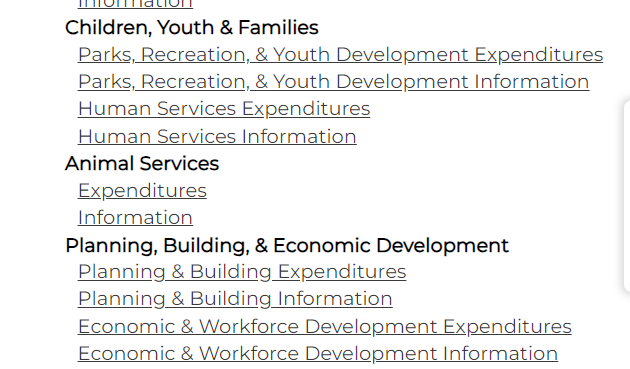
The only departments that seem ready too integrate are the Homelessness Services Division and the Housing and Community Development Department.
A Smaller FY 24-25 Budget
Even with the addition of the Coliseum funds, the recast FY 24-25 general purpose fund revenue budget is around $40 MM smaller than the biennial baseline that was created last June—that’s mostly due to the downgrading of projections of the City’s biggest revenue sources. Almost every major City source of revenue projection has been downgraded, and the revenue projection is often not just lower than the initial baseline FY 24-25 budgeted amount, it’s lower than this year’s too.
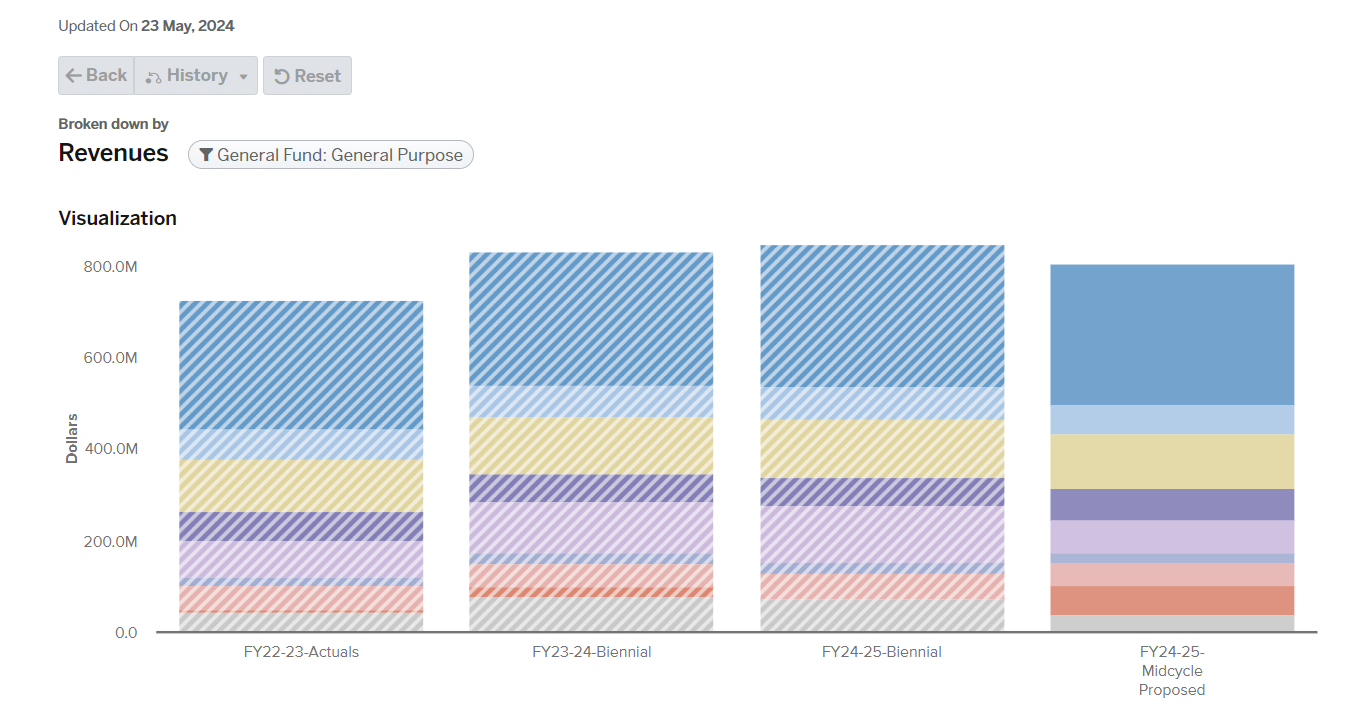
Property Tax and Business License Tax are predicted to be higher than FY 23-24, but still lower than the projections made last year for FY 24-25. The biggest recalibrated projection is in Real Estate Transfer Tax, which the City now expects to be around $47 MM lower than it initially predicted last June, following significant misjudging of that market in the current fiscal year.
Many departments are getting a GPF cut, some more than others. That won’t necessarily mean an overall cut in staff or services, since some departments run mostly on special funds and grants. According to a report from the Finance Department, there are 98 frozen or deleted positions proposed in the budget in addition to what was originally proposed in the baseline, all of them unfilled personnel positions.
OPD: Fewer Cops, Bigger Budget
While Thao's promise to carry out no layoffs is genuine, the OPD in particular is encountering a Schrodinger staffing reality. OPD’s new FY 24-25 budget is more generous than it would have been in the baseline, and higher than the FY 23-24 budget. But Thao’s budget has significant staffing freezes that reflect the reality of declining academy production and ongoing attrition of current officers.
Thao's OPD staffing is budgeted at well below sub-700 levels, from being at around 700 in the original baseline to 678 in the mid-cycle—34 positions frozen from last year’s 712. The budget literature says that Thao will be striving to keep much of patrol, Ceasefire and Crime Reduction Teams at high staffing levels, however, and will focus freezes on non-patrol functions like "Research & Planning, the Media Office, Intelligence Unit, and the Youth and School Section."
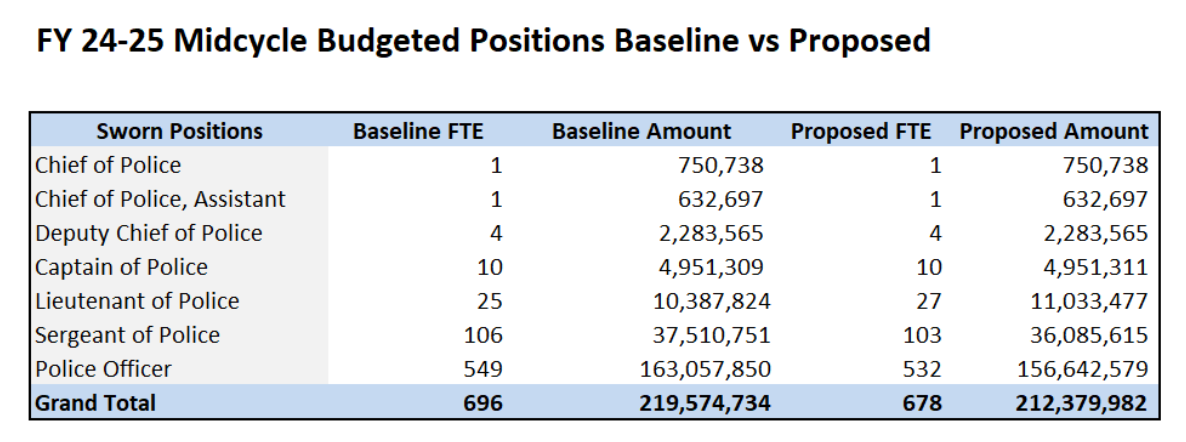
This fiscal year’s three academies have performed poorly, while attrition has remained relatively stable, causing a net loss of officers that will likely continue for the foreseeable future. Though this reporter asked Thao at Thursday's budget press conference if there was a plan to deal with the changing staffing environment, the Mayor replied that she intends to keep three academies because the problems with academies were an issue of quality rather than strictly quantity.
“Many people do decide in the middle of the academy that this is probably not the right fit, so we have to pick out the stronger candidates,” Thao responded. She added that OPD would redouble its efforts preparing candidates in feeder institutions like Merritt College.
Along with the decreasing number of graduates, and overall shrinkage of the police force, the new FY 24-25 budget amendments nearly doubles overtime expenditures to an astonishing $39.8 MM, according to the budget site. In total, the OPD budget spends about $11 MM more from the GPF and $3 MM from Measure Z—about $14 MM more than what was envisioned in the biennial baseline.
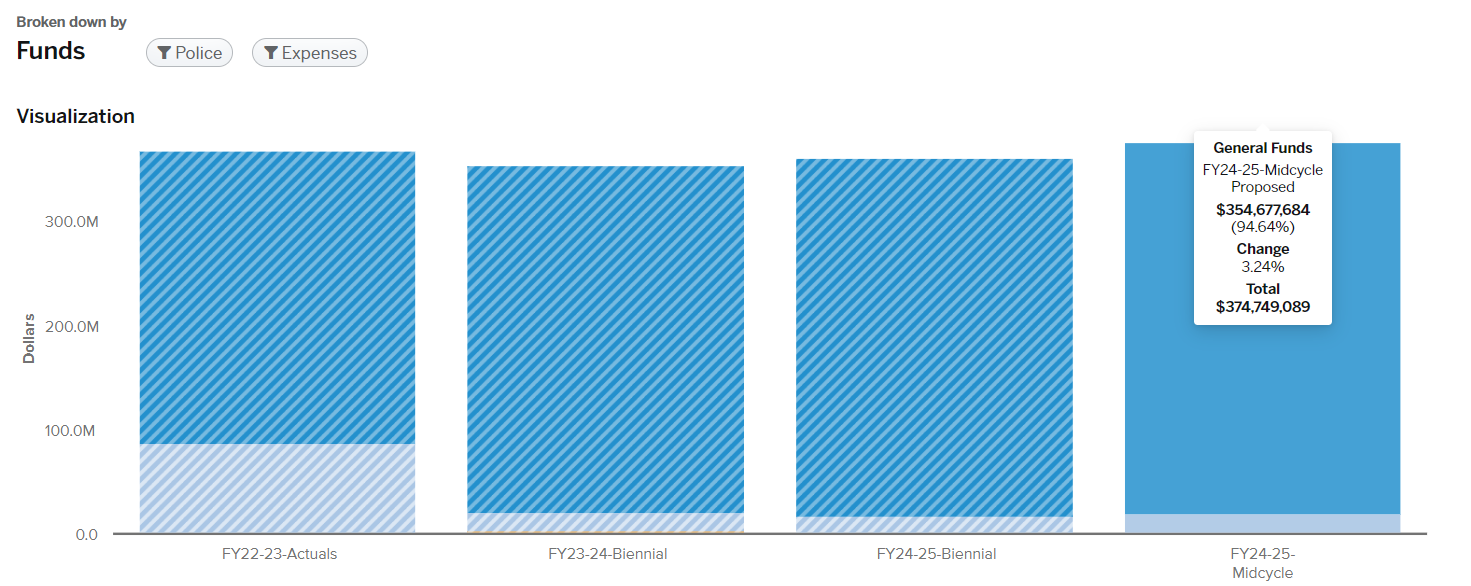
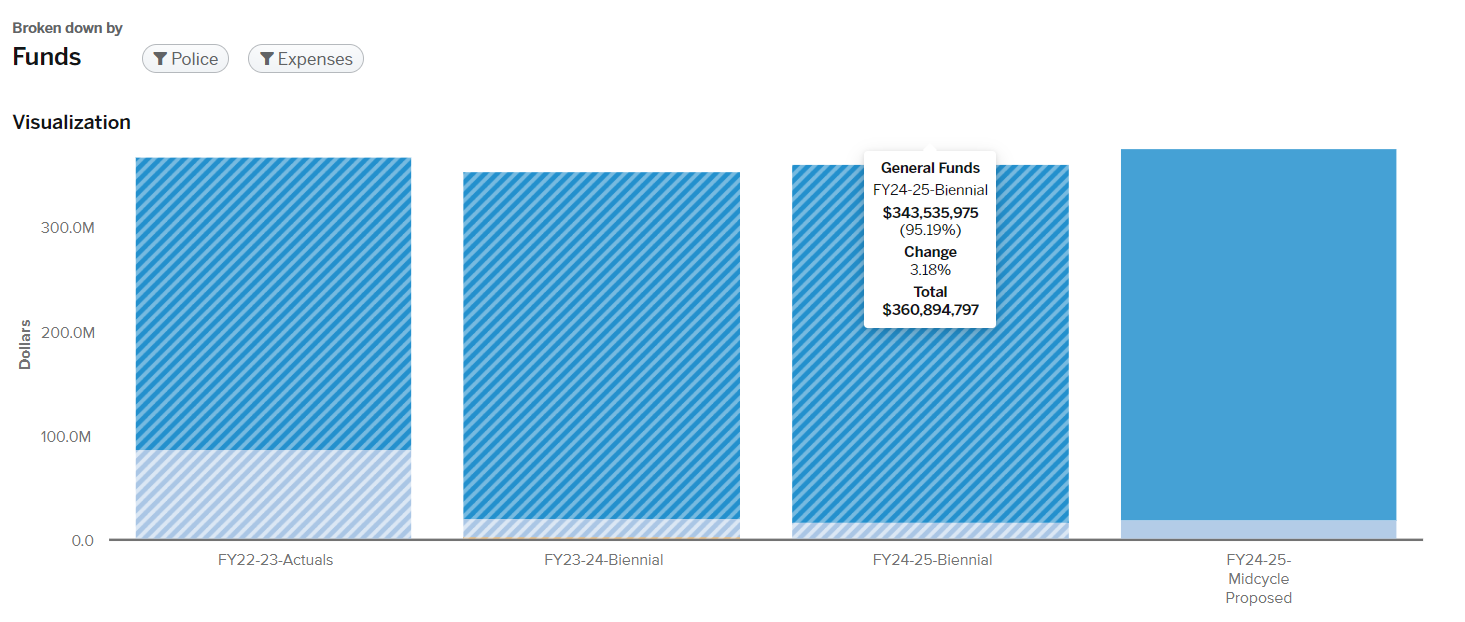
Council still must weigh in on all of these changes and could suggest different choices in their deliberations and vote on the mid-cycle budget at the end of the month. There will be a special council meeting tomorrow where many of these issues will likely be discussed.
Update 1: 5/29/2024 2:30 pm
The AASEG/50% City Share Coliseum purchase and sale agreement was agendized to the Thursday Rules Committee meeting for scheduling, with request to schedule directly to Council 6/12. No documents yet available.
🚨The AASEG Purchase & Sale Agreement have been agendized for Thursday's Rules Committee meeting. There's no text yet, but the title states payment will be in installments/sale agreement conditioned on on-site affordable housing, other community benefits. Aiming for 6/12 Council pic.twitter.com/a8d7NEMGKj
— Jaime Omar Yassin (@hyphy_republic) May 29, 2024
*City-owned property sales have become infrequent since 2014 as legislation passed that year and strengthened in later iterations through internal policy, preferences the long-term leasing of land over sales to retain flexibility, capital investment, and a long-term source of funds.
Though there would normally be clear value for the City in long-term lease development, the Coliseum property is not a straightforward leasing situation—the City could not have leased the AASEG property for the purposes of development with only a half ownership stake. Even if the A’s had first sold their half to AASEG, the City would not have been able to use lease development as it has for other projects for the same reason. The City is now and would be in the same arrangement with AASEG, only half owner in partnership with a private party, an awkward situation not solvable with a lease process.

Comments ()